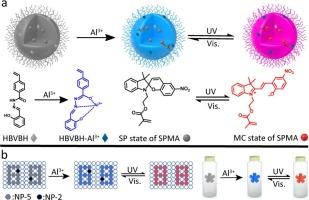用于多级信息加密和防伪的光和Al3+响应荧光聚合物纳米颗粒
IF 4.7
3区 化学
Q2 CHEMISTRY, PHYSICAL
Journal of Photochemistry and Photobiology A-chemistry
Pub Date : 2025-09-03
DOI:10.1016/j.jphotochem.2025.116747
引用次数: 0
摘要
刺激响应型荧光聚合物纳米颗粒因其制备简单、对比度高、光稳定性好等特点,在信息加密和防伪领域得到了广泛的关注。然而,目前报道的单响应纳米粒子在信息加密和防伪方面的安全性较低,限制了其应用。因此,我们通过简单的单锅微乳液聚合报道了光响应和Al3+响应的荧光聚合物纳米颗粒(PAFPNs)。基于荧光共振能量转移(FRET)机制,利用Al3+响应荧光基团((E)- n ' -(2-羟基苄基)-4-乙烯基苯并肼(HBVBH))和螺吡喃连接的甲基丙烯酸酯(SPMA)构建FRET体系。最初,纳米颗粒没有荧光。添加100 μM的Al3+后,由于HBVBH与Al3+通过金属螯合增强荧光机制(CHEF)螯合产生蓝色荧光,PAFPNs呈现出较强的蓝色荧光。随后,紫外线可以诱导SPMA从非荧光螺吡喃(SP)态到具有红色荧光的merocyanine (MC)态的光异构化过程,使荧光从蓝色转变为红色。最后,通过可见光的照射,pafpn可以恢复蓝色荧光。PAFPNs不仅具有非蓝-红三种荧光状态,而且具有较高的荧光对比度和良好的光可逆性。这些结果表明,pafpn在多层信息加密、防伪和多色安全油墨方面具有很大的发展潜力。本文章由计算机程序翻译,如有差异,请以英文原文为准。

Photo- and Al3+- responsive fluorescent polymeric nanoparticles for multilevel information encryption and anti-counterfeiting
Stimuli-responsive fluorescent polymeric nanoparticles have gained widespread interest in information encryption and anti-counterfeiting because of their features including easy preparation, high contrast, and good photostability. However, most of reported single-responsive nanoparticles exhibited the low security of information encryption and anti-counterfeiting, and limited their application. Therefore, we reported photo- and Al3+-responsive fluorescent polymeric nanoparticles (PAFPNs) through a simple one-pot miniemulsion polymerization. Based on fluorescence resonance energy transfer (FRET) mechanism, Al3+-responsive fluorescence groups ((E)-N′-(2-hydroxybenzylidene)-4-vinylbenzohydrazide (HBVBH)) and spiropyran-linked methacrylate (SPMA) were used to construct FRET systems. Initially, the nanoparticles showed no fluorescence. Upon the addition of Al3+ (100 μM), the PAFPNs revealed a strong blue fluorescence, due to the HBVBH can chelate with Al3+ to produce a blue fluorescence via a metal chelation-enhanced fluorescence mechanism (CHEF). Subsequently, UV can induce a photoisomerization process of SPMA from a non-fluorescent spiropyran (SP) state to a merocyanine (MC) form with red fluorescence, enabling a transition in fluorescence from blue to red. Finally, the PAFPNs can return to blue fluorescence via the irradiation of visible light. PAFPNs not only exhibited the three fluorescent states of no-blue-red, but also revealed high fluorescence contrast and outstanding photoreversibility. These results implied that PAFPNs have a great potential in developing multilevel information encryption, anti-counterfeiting, and multicolor security inks.
求助全文
通过发布文献求助,成功后即可免费获取论文全文。
去求助
来源期刊
CiteScore
7.90
自引率
7.00%
发文量
580
审稿时长
48 days
期刊介绍:
JPPA publishes the results of fundamental studies on all aspects of chemical phenomena induced by interactions between light and molecules/matter of all kinds.
All systems capable of being described at the molecular or integrated multimolecular level are appropriate for the journal. This includes all molecular chemical species as well as biomolecular, supramolecular, polymer and other macromolecular systems, as well as solid state photochemistry. In addition, the journal publishes studies of semiconductor and other photoactive organic and inorganic materials, photocatalysis (organic, inorganic, supramolecular and superconductor).
The scope includes condensed and gas phase photochemistry, as well as synchrotron radiation chemistry. A broad range of processes and techniques in photochemistry are covered such as light induced energy, electron and proton transfer; nonlinear photochemical behavior; mechanistic investigation of photochemical reactions and identification of the products of photochemical reactions; quantum yield determinations and measurements of rate constants for primary and secondary photochemical processes; steady-state and time-resolved emission, ultrafast spectroscopic methods, single molecule spectroscopy, time resolved X-ray diffraction, luminescence microscopy, and scattering spectroscopy applied to photochemistry. Papers in emerging and applied areas such as luminescent sensors, electroluminescence, solar energy conversion, atmospheric photochemistry, environmental remediation, and related photocatalytic chemistry are also welcome.

 求助内容:
求助内容: 应助结果提醒方式:
应助结果提醒方式:


